TENERIFE
Religion
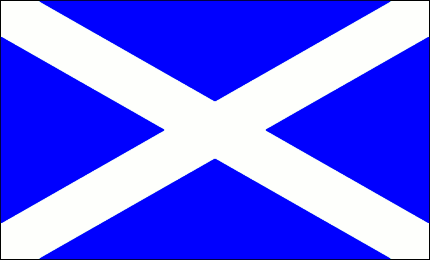
Religion

Cities in TENERIFE
| Costa adeje | Los cristianos | Playa de las americas |
Popular destinations SPAIN
| Andalusia | Catalonia | Costa blanca |
| Costa brava | Costa del sol | El hierro |
| Formentera | Fuerteventura | Gran canaria |
| Ibiza | La gomera | La palma |
| Lanzarote | Mallorca | Menorca |
| Tenerife |
Religion
The Christian faith was established with the arrival of the Spaniards in the Canary Islands. Fathers of different orders of monks founded monasteries and chapels and ensured the Christianization of the Guanches, the original population of the Canary Islands.
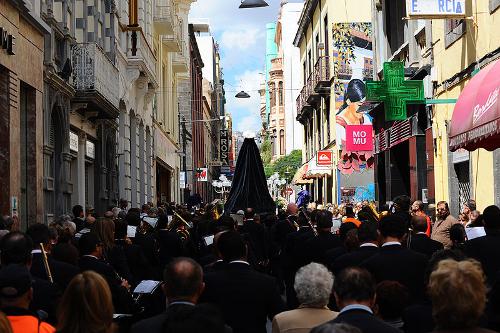 Procession in the streets of Santa Cruz, TenerifePhoto: Mstyslav Chernov CC 3.0 Unported no changes made
Procession in the streets of Santa Cruz, TenerifePhoto: Mstyslav Chernov CC 3.0 Unported no changes made
The Canarians are almost 100% Catholic and have built many churches in honor of the Blessed Virgin Mary. In addition to the regular national church holidays, many feasts and days of remembrance of a large number of saints are also celebrated exuberantly. During pilgrimages ("romerias") images of Mary, Jesus or other (protective) saints are carried. Shepherds, farmers, dancers and musicians in traditional costume walk in the procession, and the whole event is framed with all kinds of fireworks.
The patron saint of the Canary Islands is Candlemas or "Virgen de la Candelaria"; the patron saint of Gran Canaria is Our Lady of the Pine or "Nuestra Señora del Pino" and San Telmo is the patron saint of fishermen and seafarers. The Fiestas de la Cruz are festivities in cities and towns that have the word "Santa Cruz" in their name.
Roman Catholic church services are held on Sundays in most places in Tenerife.
Some important or special church buildings:
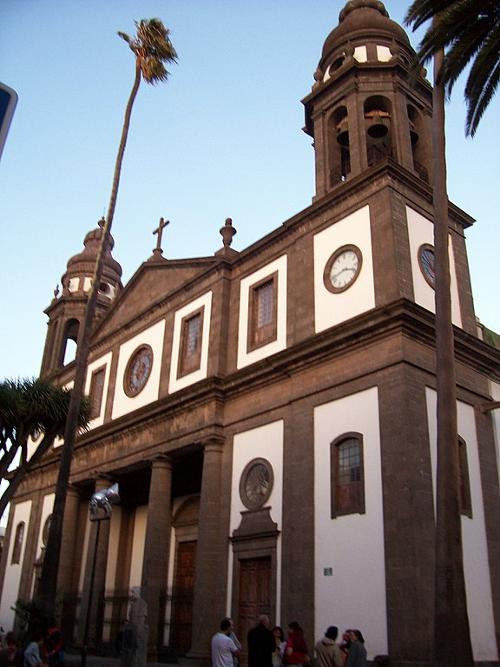 Catedral (Iglesias) Nuestra Señora de los Remedios (La Laguna, Tenerife)Photo: DailosTamanca CC 2.0 Generic no changes made
Catedral (Iglesias) Nuestra Señora de los Remedios (La Laguna, Tenerife)Photo: DailosTamanca CC 2.0 Generic no changes made
Catedral (Iglesias) Nuestra Señora de los Remedios (La Laguna): Originally a chapel from 1511, which was converted into a cathedral in 1818 when La Laguna became the seat of the bishop. The current neo-Gothic church largely dates from 1913. The tabernacle was created in 1795 by José Luján Pérez. The cathedral also has the most beautiful carved pulpit on the island, carried by a life-size white marble angel and dating back to 1767.
Iglesia de Nuestra Señora de la Concepcíon (La Laguna): originally a church from 1496, but often renovated since the 16th century and therefore elements of different style periods, gothic, renaissance and baroque. The striking seven-storey bell tower is the symbol of La Laguna and was added to the church around 1700.
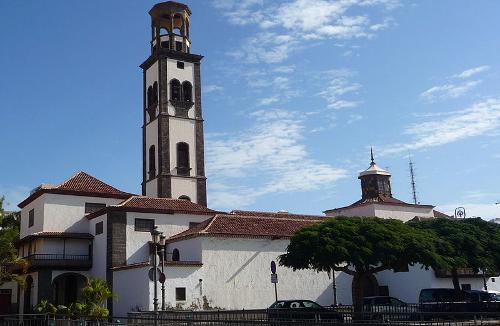 Iglesia de Nuestra Señora de la Concepción (Santa Cruz de Tenerife)Photo: Obduliez CC 2.0 Generic no changes made
Iglesia de Nuestra Señora de la Concepción (Santa Cruz de Tenerife)Photo: Obduliez CC 2.0 Generic no changes made
Iglesia de Nuestra Señora de la Concepción (Santa Cruz de Tenerife): built at the end of the 15th century and rebuilt after a fire in 1653. Church with five naves, various Baroque artworks and a wooden cross of the Spanish conqueror Alonso Fernández de Lugo. The striking five-storey bell tower was built in the 18th century from volcanic basalt blocks.
Iglesia Nuestra Señora de la Concepción (La Orotava): beautiful 18th century rococo church and national monument. A smaller dome has been placed on top of the large dome and in the side altars are the "dolorosa" statues: Mary, the Mother of the Seven Sorrows, and Saint John of Lujan.
Iglesia Nuestra Señora de la Peña de Francia (Puerto de la Cruz): the three-aisled church was built between 1684 and 1697; the baroque tower was added to the church in 1898. The pulpit was painted by De la Cruz y Rios and the altarpieces are by Estévez and Luján.
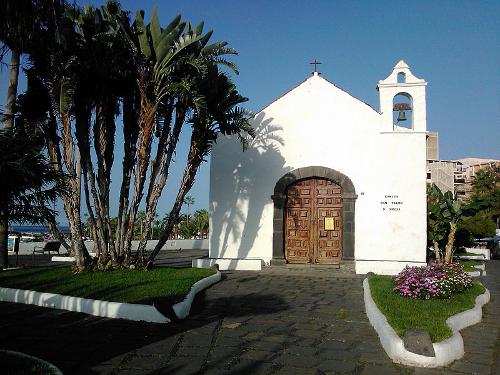 San Telmo Chapel, Puerto de la Cruz, TenerifePhoto: Daniel Gainza CC 3.0 Unported no changes made
San Telmo Chapel, Puerto de la Cruz, TenerifePhoto: Daniel Gainza CC 3.0 Unported no changes made
San Telmo Chapel (Puerto de la Cruz): Built in 1780 by sailors in honor of their patron saint, Dominican Father San Pedro Gónzalez Telmo. There are statues of the "Virgen de la Candelaria", San Martin de Peru, San Blasius, San Nicolas de Bari and of course San Telmo.
Iglesia San Marcos (Icod de los Vinos): This parish church with three aisles dates back to the 16th century and has features of late Gothic, Renaissance and Baroque style. The church has a silver cross from Mexico that is considered some of the finest filigree work in the world.
Iglesia Santiago Apóstol (Los Realejos): In the oldest church in Tenerife, the first Guanches are said to have been baptized. The colorful, oriental-looking span roof is special.
Iglesia San Agustín (Tacoronte): 17th century church with a statue of the Cristo de los Dolores (Christ of the Sorrows).
Iglesia Santa Catalina (Tacoronte): 17th-18th century church with beautiful Mudéjar tower and high altar with Mexican silverware.
Basilica Nuestra Señora de la Candelaria (Candelaria): the neo-Canarian basilica is dedicated to the Madonna of the Torch (Candlemas), the patron saint of the Canary Islands. In the middle of August, pilgrims congregate on the main square.
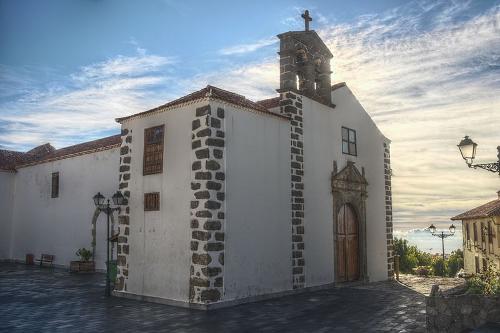 Iglesia de San Pedro, Vilaflor TenerifePhoto: Javier Sánchez Portero CC 3.0 Unported no changes made
Iglesia de San Pedro, Vilaflor TenerifePhoto: Javier Sánchez Portero CC 3.0 Unported no changes made
Iglesia San Pedro (Vilaflor): this church was built by the Vilaflor missionary and preacher Hermano Pedro. The interior features a 16th-century white marble alabaster statue of Saint Peter.
Most churches have three naves with some side chapels. Special are the wooden ceilings, characteristic of the architecture of the "mujédars". The mujédars were Moors who developed their own art style in areas recaptured by Christians.
The mostly 17th century baroque high altar often covers the entire back wall of the church and is richly decorated with many images of saints. Each church has several altars. The oldest statues were made by Spanish, but also often by Flemish sculptors.
Sources
Gruschwitz, B.F. / Canarische Eilanden
Het Spectrum
Klöcker, H. / Tenerife
Zuidnederlandse Uitgeverij
Krause, D. / Tenerife
ANWB,
Nowaczyk, D. / Tenerife
Van Reemst
Rokebrand, R. / Reishandboek Tenerife
Elmar
CIA - World Factbook
BBC - Country Profiles
Copyright: Team The World of Info